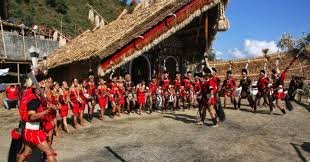CM Rio Opens New Amenities at Kisama for Hornbill Festival
Introduction to the Hornbill Festival
The Hornbill Festival is one of the most prominent cultural celebrations in Nagaland, India. It is a week-long festival that showcases the rich traditions, culture, and heritage of the Naga tribes. Held annually in Kisama, a village near Kohima, the festival attracts visitors from around the world. Known as the “Festival of Festivals,” it promotes unity among the 16 different Naga tribes and serves as a platform for cultural exchange and tourism.
CM Rio’s Role in Enhancing the Festival
On the occasion of the Hornbill Festival 2024, Chief Minister Neiphiu Rio inaugurated new amenities at the Kisama Heritage Village, significantly improving the infrastructure for both visitors and participants. These amenities include upgraded facilities, better roads, modern sanitation, and more accessible event spaces, designed to provide a seamless experience to thousands of attendees. The initiative aims to ensure that the festival runs smoothly and meets the growing demands of the increasing number of domestic and international tourists.
Focus on Sustainability and Community Engagement
A notable feature of this year’s improvements is the emphasis on sustainability. CM Rio highlighted the importance of making the festival eco-friendly by incorporating waste management systems and promoting green practices. Additionally, local communities have been involved in the development of these amenities, ensuring that the festival benefits not only visitors but also the local economy. The inclusion of cultural stalls, handcraft exhibitions, and food festivals aims to highlight the uniqueness of Naga traditions while supporting local artisans.
Significance of the Development for Tourism
The upgrades at Kisama are expected to give a boost to Nagaland’s tourism sector. The Hornbill Festival, already a major tourist attraction, will now offer enhanced facilities, potentially attracting more visitors. This development will also highlight Nagaland as a prime destination for cultural tourism, thus opening new avenues for the state’s economic growth. The state government aims to showcase its rich cultural heritage to the world through these improvements.

Why this News is Important
Promoting Cultural Heritage
The inauguration of new amenities at Kisama for the Hornbill Festival is a significant step towards preserving and promoting the cultural heritage of Nagaland. With the state’s rich traditions and diverse tribal cultures, it’s essential that these are showcased in a manner that is respectful and sustainable. The festival has become a key platform for the Naga people to celebrate their identity and showcase their traditions, and the recent infrastructure upgrades will enhance the experience for both locals and tourists.
Boosting Tourism and Economy
By improving the amenities at Kisama, the state government is positioning Nagaland as a key player in India’s tourism industry. The Hornbill Festival’s growth, aided by these upgrades, will bring in more tourists, boosting the local economy. This aligns with the government’s strategy to boost tourism and employment opportunities in the region. Increased tourist traffic will help local businesses thrive, from food vendors to souvenir shops, and will provide a platform for the state to show its potential for sustainable development.
Improving Infrastructure for the Future
The development of better roads, sanitation, and event spaces will make the festival more accessible to a wider audience. These infrastructure improvements will not only make the festival more enjoyable for tourists but will also set a benchmark for future event management in Nagaland. Sustainable development in festival management is critical for the long-term success of tourism in the region, ensuring that the natural beauty of Nagaland is preserved while fostering economic growth.
Historical Context
The Evolution of the Hornbill Festival
The Hornbill Festival was first launched in 2000 as part of Nagaland’s statehood celebrations. It was created to promote the rich cultural diversity of the state and to unite the different Naga tribes. Over the years, it has evolved from a local event into a major international cultural festival. Today, it features a wide range of activities such as traditional dance, music, arts, crafts, and indigenous games. The festival has become a symbol of Naga unity, culture, and pride.
Previous Efforts to Improve the Festival’s Infrastructure
Infrastructure development for the Hornbill Festival has always been a priority for the state government. In previous years, the government has introduced improvements such as upgraded exhibition halls, better transportation facilities, and enhanced safety measures. These developments are part of the long-term goal to make Kisama a world-class venue for cultural tourism. This year’s improvements are seen as a continuation of these efforts to provide a better experience for both locals and visitors.
Key Takeaways from “CM Rio Opens New Amenities at Kisama for Hornbill Festival”
| Serial Number | Key Takeaway |
|---|---|
| 1 | Chief Minister Neiphiu Rio inaugurated new amenities at Kisama to improve infrastructure for the festival. |
| 2 | The new developments include upgraded sanitation, better roads, and more accessible event spaces. |
| 3 | The festival emphasizes sustainability, with eco-friendly practices like waste management systems. |
| 4 | The upgrades aim to boost Nagaland’s tourism sector, showcasing the state as a cultural tourism hub. |
| 5 | Local communities have been involved in the development, ensuring benefits for the regional economy. |
Important FAQs for Students from this News
What is the Hornbill Festival?
- The Hornbill Festival is an annual cultural event held in Nagaland, India, celebrating the rich traditions, culture, and heritage of the Naga tribes. It is often referred to as the “Festival of Festivals” and is a major attraction for both domestic and international tourists.
Where is the Hornbill Festival held?
- The festival is held at Kisama Heritage Village, located near Kohima, the capital city of Nagaland.
What new amenities were introduced at Kisama for the 2024 Hornbill Festival?
- Chief Minister Neiphiu Rio inaugurated new amenities, including upgraded sanitation facilities, improved roads, accessible event spaces, and waste management systems, ensuring a better experience for attendees.
How does the infrastructure improvement at Kisama benefit tourism?
- The infrastructure improvements aim to boost Nagaland’s tourism sector by providing enhanced facilities, attracting more visitors, and promoting sustainable development, which benefits the local economy and culture.
Why is sustainability a focus at the Hornbill Festival?
- The focus on sustainability includes practices like waste management and promoting eco-friendly initiatives. These efforts aim to preserve the natural environment while hosting a large-scale cultural event.
Some Important Current Affairs Links


















 Exciting News!
Exciting News!  Join Our Telegram Channel Now!
Join Our Telegram Channel Now!
 Join our Telegram channel for a thrilling adventure into the world of daily current affairs.
Join our Telegram channel for a thrilling adventure into the world of daily current affairs. 
 Don’t miss out on the latest updates and insights! Click to join now and be part of the knowledge revolution!
Don’t miss out on the latest updates and insights! Click to join now and be part of the knowledge revolution! 
